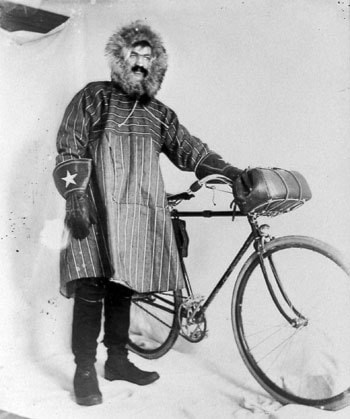Carbon fibre, polished aluminum and moisture-wicking clothing appearing better suited to space travel than the great outdoors: these are the tools that will accompany me on the long, cold journey that lies ahead.
It’s hard not to marvel at the contrast between the modern picture I present, and that of a man who captured my imagination some 15 years ago and has held it ever since. He wears a tailored parka, its fur ruff framing a determined look as he stands beside a bicycle forged from steel and iron wearing simple leather accessories. No aluminum or carbon (but for the fire in the pipe I imagine he lights up during infrequent rest breaks).
The caption underneath his portrait, taken circa 1900, reads “B.H. Svendson Rode Bike from Skagway to Dawson on Stage Line Road.”
As I set out on Sunday sharing the same objective as Svendson, it’s hard to feel like little more than an imposter - a modern-day fool cocooned in puffy layers designed to render the cold of the winter road to the Klondike bearable. I have entered the full-distance mountain bike category of the Yukon Arctic Ultra -“The World’s Coldest and Toughest Ultra” - which in odd-numbered years follows the route of the Yukon Quest International Sled Dog Race from Whitehorse to Dawson, a distance of 430 miles, or 700 kilometres.
It’s a bad idea, but I’ve had worse.
At least this bad idea, unlike the others preceding it, has given me licence to delve into the remarkable history of bicycles on snow in the Yukon Territory. It so happens that at the turn of the century, shortly after the establishment of the Overland Trail connecting Whitehorse to Dawson, a breed of traveller known as a “wheelman” appeared on the snowy trails of the Yukon interior. As John Firth recounts in his Yukon Sport: An Illustrated Encyclopedia, “For most of Yukon history, bicycling was a means of winter transportation rather than a competitive summer pastime ... it was estimated that the journey on the frozen highway of the Yukon River between Bennett, B.C. and Dawson City would take 10 to 14 days. The greatest risk was severe frostbite. The advantage was the cost.”
While the threat of frostbite remains, the economy of an overland trip to Dawson by bicycle is a relic of the past. In Svendson’s day, roadhouses were spaced at regular distances along the trail, each an oasis of warmth where a wheelman could purchase food and dry boots and prepare for the next day. Today, all that remains of this once vital part of Yukon’s transportation infrastructure are a handful of decaying log cabins.
Each year the organizers of the Yukon Quest and Yukon Arctic Ultra temporarily restore this lost transportation artery and bring long-forgotten place names such as “Dog Grave” Lake back into use. This year, 31 individuals have signed up to follow in Svendson’s tire tracks to Dawson, joined by 56 others contesting shorter distances. For a fee (2,450 euros in 2015, with a discount given to Yukoners), competitors are welcomed at checkpoints spaced a day’s travel apart and supplied with hot water, wood heat, and companionship.
This historic and stunningly scenic route would have faded away into the landscape had it not been for the Yukon Quest in particular. Today the Canadian Rangers break open the trail every January at once restoring, preserving, and evolving the route as nature demands. It’s a monumental effort of time and money, and after the dogs and mushers pass through, the trail is open to anyone seeking adventure and the chance to pay homage to the mail carriers of the last century.
For many of the competitors, the Arctic Ultra presents an extreme challenge akin to scaling to Everest or skiing to the South Pole. For me, the race presents the opportunity to relive that two-wheeled history on the unique heritage and recreational resource that is the overland trail to Dawson. My research efforts indicate that a full century may have passed since a Yukoner “wheeled” a bike from Whitehorse to Dawson in the winter. The advantages of technology would seem to tip the balance in my favour, but success seems far from assured.
A journalist recently asked me if being a Yukon resident would be an advantage in tackling those 700 kilometres of trail. My response was “no.” Unlike many of my counterparts in the Ultra, I know all too well the feeling of 40 below seeping into my bones, and how fiercely the wind blows across the high summits of the Klondike. Perhaps I have read Jack London’s To Build a Fire too many times, and check the weather in Carmacks too often. I hold no delusions about the external environment I’ll be facing; rather, the mystery lies in the internal environment I can maintain in spite of it.
There is no account of the time it took that Bjorn Svendson to wheel his bike to the Klondike. Numerous reports refer to a record time of five days between Whitehorse and Dawson in the Gold Rush era; in contrast, the fastest time ever recorded in the Yukon Arctic Ultra is just under seven and a half days. My carbon-fibre wonder-bike with five-inch tires may deliver me in 10 days, if all goes well.
Surprisingly, the old-timers had one big advantage: the narrow tires of their bicycles fit perfectly into the runner track of the mail and freight sleighs that frequented the route. There will be no slot-car track to convey me swiftly to Dawson. Instead, the snow machines that serve to ensure safety and a broken-in trail for the event may stir up soft snow into an unrideable state in some sections.
Regardless of the possible futility of the outing, I’ll be at the trailhead in Shipyards Park this Sunday morning to give it my best. May the spirits of Svendson and his fellow Klondike wheelmen register their approval by sending the odd tailwind my way!
